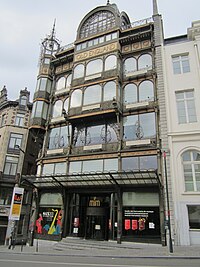Musical Instrument Museum (Brussels)
| Musée des instruments de musique / Muziekinstrumentenmuseum | |

Exterior of the museum building.
|
|
| Established | 1877 |
|---|---|
| Location | Montagne de la Cour/Hofberg 2, B-1000 Brussels, Belgium |
| Coordinates | 50°50′34″N 4°21′32″E / 50.842836°N 4.358831°E |
| Type | Musical museum |
| Nearest car park | No |
| Website | www |
The Musical Instruments Museum (MIM) is a music museum in central Brussels, Belgium. It is part of the Royal Museums for Art and History and internationally renowned for its collection of over 8,000 instruments.
Originally attached to the Royal Conservatory of Brussels with the purpose of demonstrating early instruments to students, the MIM collection was created in 1877 with a collection of a hundred Indian instruments given to Belgian King Leopold II by Rajah Sourindro Mohun Tagore in 1876 and the collection of the celebrated Belgian musicologist François-Joseph Fétis, purchased by the Belgian government in 1872 and put on deposit in the Conservatory, where Fétis was the first director.
Its first curator, Victor-Charles Mahillon, greatly expanded the already impressive collection so that, by the time of his death in 1924, the MIM consisted of some 3,666 articles, among which 3,177 were original musical instruments. He was noted of his astute judgments in obtaining these large augmentations by calling on philanthropists, mixing with erudite amateurs who sometimes became generous donors, and through friendly relations with Belgian diplomats in foreign posts, who sometimes brought back instruments from beyond Europe.
The monumental five-volume catalogue of the collection Mahillon commissioned between 1880 and 1922 also included four versions of his essay on the methodical classification of both ancient and modern instruments, which was to serve as the basis for the organological Hornbostel-Sachs classification systems still used today. Beginning in 1877, Mahillon also created a restoration workshop in the MIM where he employed and trained a worker, Franz de Vestibule, to restore damaged articles and make copies of unique instruments in other public collections.
Mahillon's successor at the Conservatory, François-Auguste Gevaert, organized several successful concerts of professors and students playing early instruments in the 1880s.
...
Wikipedia

